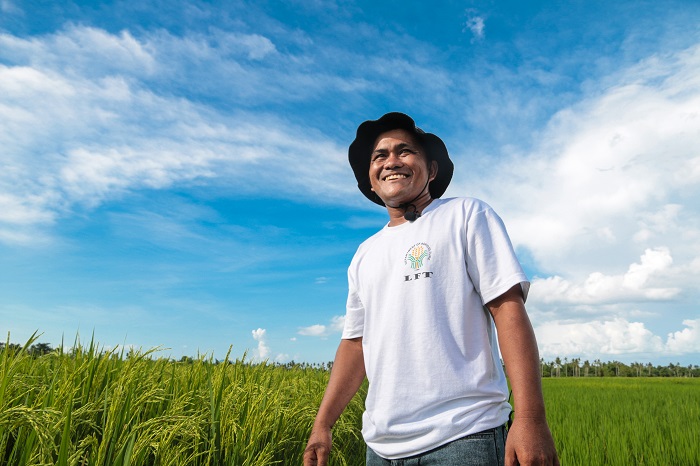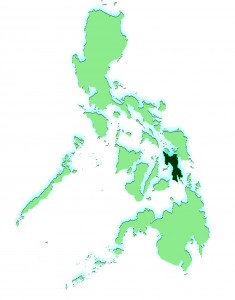More than two years after Typhoon Haiyan devastated the island of Leyte in the Philippines, the survivors, especially the farmers, are still struggling to rebuild their lives. Green Super Rice (GSR) is giving them a fighting chance.


When Typhoon Haiyan struck Leyte Island in the central Philippines in November 2013, parts of the house of Nemesio Retales were destroyed, with the roof being torn off. Mr. Retales, a farmer and village councilor for a farming community within the island’s southern municipality of Dagami, recalled, “I rushed inside our room to fetch my wife. Seconds later, a coconut tree fell down onto where I had originally been standing.”
Felicito Montano, a farmer from the municipality of Tanauan, had a similar brush with one of the most powerful typhoons ever recorded. “If you could just experience what it was like then,” he said. “Because our roof was gone, we slept under an umbrella. Some nights were more difficult because of the rains. I still feel like crying whenever I think of what we’ve been through.”
Lost livelihoods
Destruction was everywhere, Mr. Montano vividly recalled: “Before the storm, the trees, especially the coconuts, were so thick and lush one could hardly see the sunlight coming through their leaves. Now, these lush trees are either uprooted or mangled.”
Although some survivors are now recovering, others are still struggling to get back on their feet because most of the coconuts, on which most farmers depended for their livelihood, were destroyed.
Without the coconuts, Mr. Montano’s financial circumstances changed. “Before the storm, I could earn enough income from the coconuts and send money to my sister and mother and still support my family. I had 60 trees and I could harvest as many as 1,000 coconuts,” he exclaimed. “When the coconut price was high, I could earn as much as USD 167 in three months. I was also growing rice and vegetables. I had enough to tide me over back then.”
Farmers started replanting coconut palms, but it will take at least five years before these start producing fruits.
Listen to Efren Lazarte and Felicito Montano talk about their success with GSR.
Another green option
A silver lining to their gloomy situation came in the form of Green Super Rice (GSR) seeds. GSR varieties bred at the International Rice Research Institute (IRRI) can thrive in harsh environments such as areas prone to flooding, drought, and salty soils, according to Jauhar Ali, IRRI’s GSR project leader and coordinator for Asia. The seeds had reached the farmers through Evelyn Gergon, a crop protection specialist from the Philippine Rice Research Institute (PhilRice), several months before the typhoon came.
“Until now, most farmers in the Philippines prefer to use seeds they have saved from the previous crop instead of certified ones,” explained Dr. Gergon. “This is why we decided to conduct training on high-quality seed production. I heard about GSR when Dr. Ali went to PhilRice to talk about the new rice in a seminar. That was the beginning of how my team and I were able to bring GSR to farmers in Leyte.”

Mr. Montano was one of the first farmers to grow the tough variety GSR 8. “I planted it for the first time after I was given 2 kilograms of certified seed after I completed a two-day training course on high-quality seed production at Visayas State University,” he said. He sowed those 2 kilograms of GSR seed and harvested 12 sacks from the first crop. Planting some of the harvested seed for his second crop, he was able to harvest 70 sacks, weighing from 45 to 50 kilos each. “That was double what I’d usually get from other varieties,” he remarked.
Aside from being hardy and high-yielding, GSR 8 is an early-maturing variety. “That was fortunate because we were able to harvest our rice before the typhoon came in November,” recounted Mr. Montano.
GSR—much better than the average rice
“Although many farmers were hesitant to plant GSR at first, we received really good feedback from them after they gave it a try,” Dr. Gergon explained. “Many farmers told me how great GSR performed in their fields. Some farmers reported that they were able to obtain as much as 11 tons per hectare—2.75 times the average yield of 4 tons in Leyte! Some farmers asked us to try eating the cooked rice. We hadn’t even tasted GSR then and so we did. It tasted good!”
“I like GSR because its grains are good and weigh considerably heavier than the previous rice grains I tried in the past,” said Mr. Montano. “The crop is tolerant of pests and diseases. Lately, we’ve also started shifting to organic fertilizers instead of chemical ones.
“I wouldn’t be surprised if everyone in our village will soon be planting GSR,” added Mr. Montano. He has been using GSR 8 for six seasons and hasn’t shifted to another variety yet and has shared his seed with other farmers, including Efren Lazarte, who planted GSR 8 on 2 hectares of his land.
”It really performed well even in rainfed fields such as mine,” Mr. Lazarte said. “Growing GSR following the recommended management practices really paid off. Even after three weeks without rain, I was still able to harvest a good crop.”
“I have shared these stories with Dr. Ali, but there are still countless farmer successes out there to regale,” said Dr. Gergon.
Back to taking care of business
“Even though we were badly affected by the typhoon, we were able to improve our livelihood and get back on our feet because of GSR 8,” Mr. Lazarte exclaimed. “Adjusting to the situation was hard at first because I am used to making more money from coconuts. But, I was even able to purchase a hand tractor. Now, it’s easier for me to grow rice. I’m really thankful for GSR and I hope that many other farmers will also be able to plant it.”
Mr. Retales agrees. “Since our coconuts were destroyed by the typhoon, our rice fields are now our main source of livelihood,” he concluded.
“GSR varieties have contributed enormously to the resilience of coastal paddy farming communities to withstand the periodic typhoons that often uproot their very livelihoods,” said Dr. Ali. “I feel immensely rewarded to see our breeding efforts in helping to shape the communities in fragile environments.”
Ms. Ferrer is a communication specialist at IRRI.







I would like to thank you for sharing the information about the GSR- rice. It is very interesting and I would try and plant GSR in our rice field. Kindly let me know where to get GSR seeds. More Power to the Team IRRI.
Sincerely Yours,
Nelson Fontelera
saan po ako pwede makabili ng green super rice (gsr).
taga caibiran biliran po lugar ko
saan po pwede makabili green super rice GSR taga alicia isabela po ako.
saan po pwede kumuha o bumili ng GSR
Very interesting to know about green super rice. Where i can get or purchase GSR seeds and we could try to plant this coming planting season. More power to the team. Thank you
Nelson
we cannot reach you at your email address. do you have an alternative email? thank you.